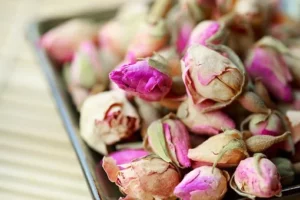Drying and Preserving Flowers
5 Methods to Dry Cut Flowers

Whether you’re growing flowers in your garden, from containers indoors, your porch or patio, or maybe a hanging basket one thing that we can all agree on is flowers can light up a garden or a room with their various colors, shape, sizes, textures, and fragrance. The presence of flowers has been known to change the atmosphere and moods of people from all walks of life. It’s no wonder why flowers have been used and are being used to brighten up that special someone’s day.
But as beautiful as flowers are especially when used as cut flowers they won’t last forever but the good news is we can dry and preserve those cut flowers that will help to create lasting memories. For more on drying and preserving flowers let’s take a closer look.
1. Pressing flowers
This process involves using objects that are heavy, to squeeze out the flower’s moisture, this method of drying flowers is great for stationery artwork and craft. Flowers that have thick petals or that are flat are ideal when using this style of drying, place your flowers between 2 pieces of wax paper or parchment. Next lay them on a flat table, a large thick book can also be used, open up the middle and line the pages with non-stick paper.
Place an object that’s heavy and flat on top of the paper containing the flowers or close the book that your flowers are being dried in. For the best results, locate your flowers in an area that’s dry, warm, and dark. After a week or thereabout check your plants, remove the old paper and replace it with fresh dry paper. This process should be repeated until the flowers have completely dried which may take about 1 month.
2. Air drying
Air drying is another method that’s used to dry flowers, this technique is performed by removing all the leaves from your flowers and cutting the stems to the desired length. If you’re drying more than one species of flower type then separate and keep each species together, with a twine wire or rubber band bind each group together and hang upside down in the open air. For flowers to dry completely will take anywhere from 2 to 4 weeks or maybe a little longer.
3. Baking
Baking your flower bloom is also a popular and quick method even though this way gives good results a lot of flowers may be lost in the process along with their color. The way this works however is striping your flowers off the leaves, lay your flower blooms out on a baking rack that’s placed on a cookie sheet in the oven, and baking at about 200 degrees Fahrenheit for 2 hours. Keep checking and if they begin to shrivel then remove them. Now let your flowers dry.
4. Microwaving
The results you will get with microwaving your flowers are much quicker allowing you to see results within days, this method works by stripping your flowers of leaves and cutting the stem so it can fit into your microwave-safe container. Before placing your flower into the container fill it with a layer of moisture-absorbing desiccant like silica.
Next place your flower on the top, with your flower on the top of your first silica layer, fill up the rest of the container with silica. Place the container with the flower in the microwave along with a measuring cup of water which will help the flower from drying out too much.
Your flower should be heated in the microwave at 30-second increments. Once the flowers feel dry to the touch remove them from the microwave. For about a full day leave the flower in the silica, for cleaning off.
5. Desiccant method
Strip your flowers of their leaves, cut the stems to the desired length to fit into the container, the container that’s chosen should be large for your flower cuttings. Silica gel with a little salt or kitty litter can be used to wick the moisture from your flowers, pour your desiccant into the container to create a bed for your flower.
Submerge your cut flowers in the desiccant and cover them, make sure that it’s tightly sealed or locked, this process of drying may take anywhere from 2 days to about 1 week. Keeping a check on them and once the petals are dried they are ready, ensure that the excess sand is removed, however.
17 Flowers that’s easy to dry and preserve

- Larkspur ‘guardian lavender
- Roses
- African daisy ‘soprano’
- Baby’s breath
- Sundaze blaze strawflower
- Tulips
- Statice
- Ranunculus
- Lavender
- Yarrow
- Hydrangeas
- Pnasiolas
- Celosia ‘dragon’s breath’
- Globe thistle
- Chrysanthemums
- Gerbera daisies
- Globe amaranth’forest pink’
The final word on decorative dried flowers
Drying and preserving flowers are that simple, these methods will help you preserve your favorite flowers allowing you to create those memories. I believe that the process of drying flowers is a work of art that is so amazing, why let those flowers which that special someone sent you lost their luster when these methods can allow them to last so much more longer. Now let’s get to work by using one or more of these methods as you preserve your floral arrangement.
About the author
Norman loves being in the garden, both at home and for his job....
he is 'Natures Little helper' being outdoors, growing his vegetables and flowers from an early age.
Now having spent over 22 years in the profession he want to give some of his knowledge to others...
his vast array of hints and tips you will find scattered over this site will help you no end growing plants in your garden.

With valentines day around the corner, this article is just perfect. I do not know why, but females absolutely love flowers. I will be sure to bookmark this article and come back to it closer to valentines day. I will be sure to buy my partner some flowers from this site.
The beauty and the fragrance of flowers can get almost any female smiling, the presence of flowers can bring much flavor to a dull area. I am so happy to help and thanks a million for your support. All the best to you and have a good day.
I used to be a gardener many moons ago but mainly concentrated on the landscaping side. I never knew you could do some of these ways to dry flowers, I’m totally amazed at the fact you can microwave them!! As my wife is the artistic one in the house I will definitely be showing her you article some good ideas here.
Thanks keep up the good work!
This field is so exciting providing you the opportunity to get creative, I am so happy to help, and thanks so much for sharing my post with your wife. All the best to both of you and have a good day!!
I have tried to dry flowers on a few occasions but I’ve never had any success. I was interested to read this post and find out what I was doing wrong. I know now that my problem with pressing or hanging the flowers is that I didn’t give it enough time. I think that by touching them too much during the drying process also damaged the petals. Of all the methods you list here, I think I still like the pressing or hanging method. Thanks for posting!
I am so happy to help and wish you great success as you engage in this fun-filled hobby. Have a great day!
I just bookmarked your website. My experience in gardening has been predominantly vegetables and fruits, but I found your discussion on drying flowers intriguing, to the point I would like to give it a try. Christmas is approaching, so there should be plenty of opportunities.
I do have a question regarding the microwave method–after placing the flower on top of a layer of silica, do you then completely bury the flower in more silica, or just sprinkle silica on the flower? Since that is the quickest way to see results, I think that might e the best way to dry a variety of flowers and see which turn out the best.
I just checked our Crepe Myrtle out front, but I afraid it’s season is past for this year. Although it isn’t on your list, I definitely will give it a try next spring.
i look forward to checking out the rest of your website. Best wishes,
Joe
Hello, I am so happy to help and thanks so much for bookmarking my website as for your question.
With your flower on top of your first silica layer, fill up the rest of the container with silica, I hope this helps and thanks again for stopping please let me know how it goes, all the best to you.